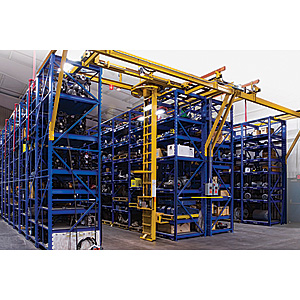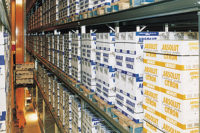“SKU proliferation is the largest change the industry has seen in the last decade,” says Aaron Corcoran, account executive for Westfalia Technologies Inc., York, Pa. “While beverage growth only averages 1 percent per year, SKUs have increased 100 percent, with warehouses going from 300 to 400 SKUs to 1,200 to 1,500 and growing.”
Although new products can be a benefit for sales, they also pose multiple challenges in managing and storing the inventory, Corcoran notes. “More SKUs must be accounted for in many ways: number of total storage positions needed, inventory levels become more dynamic, manual pick areas grow larger and more complex, replenishment tasks have become a larger burden on warehouse manpower, etc.,” he explains.
|
Of these challenges, one of the top concerns is finding room for the new SKUs. Many warehouses were designed for storing fewer SKUs at a pallet-handling and -storage level, notes Sean O’Farrell, market development director for Grand Rapids, Mich.-based Dematic Corp. “The increase in SKUs with movement at a layer or case level is impacting the space of the warehouse that was designed for pallet-level handling,” he says.
When deciding how to manage their storage, beverage companies first can look at whether they have the capital and space to build a new, bigger building, advises John Barry, vice president of sales and marketing for ITW Warehouse Automation. If not, then they need to get creative with efficient storage solutions for their existing buildings, he says.
The Arden, N.C.-based company offers storage solutions for stacking to take advantage of vertical space within a warehouse. Its StorFast cart-based automated storage and retrieval system (AS/RS) uses a two-cart system, one at the front of each aisle that moves up and down each column and one that moves through each aisle, to deliver pallets to predetermined locations within racks positioned at different heights. The multi-cart system builds in redundancy to increase throughput and efficiency, the company says. In addition, because the system is modular, companies can expand the system to accommodate even more SKUs as their portfolios grow, it says. Although such systems previously were limited to two and three levels high, the StorFast system can take advantage of the complete density of available space, Barry adds.
Vidmar, an Allentown, Pa.-based division of Stanley Black & Decker, also offers an adjustable racking system, which can vertically store items as heavy as 4,000 pounds up to 18 feet high. The Vidmar Stak System consists of removable, adjustable pallets and a captive lifting and handling device and can fully operate in as little as 250 square feet, the company says. This offers up to 70 percent space savings compared with horizontal-beam rack storage, it adds.
In addition to height, AS/RS systems are taking advantage of depth as well, using up the whole volume of available space. For example, Westfalia’s AS/RS systems can store products as far back as 18 pallets deep in each lane of storage, Corcoran says. “With depth as an advantage, the space needed to store the same number of pallets with a Westfalia AS/RS versus traditional block storage is dramatically reduced,” he says.
These space efficiencies are important for large and small companies, Corcoran notes. “Smaller warehouses have all the typical complexities as larger ones but have to do it with less space and resources,” he explains. “AS/RS solutions allow that smaller space to [be] utilized in a more efficient manner and optimize daily operations. This creates more space and time to service their customers more effectively, opening up opportunities for them to take on more value-added work or service a larger amount of customers out of this small space.”
Pick up the pace
Once the storage space is configured, operators need to consider how to quickly store and retrieve the needed items accurately and efficiently, Dematic’s O’Farrell says.
By switching to an AS/RS, distribution center managers can take the complexity of managing multiple SKUs out of the hands of manual laborers and entrust it to machines and software designed to handle those tasks, Westfalia’s Corcoran explains. “AS/RS solutions provide a service inside the warehouse that minimizes both the overhead aspect of operations along with taking the operational complexity out of the hands of operators and putting it into the software, which manages both the equipment and much of the data flow inside the warehouse,” he says.
The speed and efficiency benefits of AS/RS tend to offer the most benefits to the industry’s biggest players. “From a price per case delivered [viewpoint], larger warehouses will see the greatest impact to the bottom line because of the volume they move,” Westfalia’s Corcoran explains. “The more volume of product you move, the higher your manpower associated with fulfilling the operational tasks.”
Warehouses with slower-moving SKUs also can benefit from the automation. Because these types of items tend to be expensive to store and pick, Dematic offers a Slow Movers Module that adds small amounts of automation inside an existing operation that handles the slowest-moving SKUs for grocery and foodservice businesses, O’Farrell points out. The AS/RS stores the slow-moving SKUs in the upper levels and then retrieves them and places them at an ergonomic level for the human picker when they are needed. Pick operators are able to pick 300 percent faster when utilizing this system, O’Farrell adds.
Beyond efficiency, AS/RS machines also are being designed to handle the increasing complexities of beverage product and order management. For example, with packaging trends leaning toward lightweighting and unique package shapes, AS/RS operations need to handle products carefully, O’Farrell says. As such, Dematic has focused on developing automation strategies that require minimal product handling for storage, retrieval and eventual pallet building for delivery.
Westfalia also is exploring ways AS/RS can help with the complexities of order picking, which now require case-level picking to create rainbow pallets, as opposed to single-SKU pallets. This, in turn, requires a larger and more complex area for picking these orders, Corcoran says. “More SKUs either in pallet form or in case-flow racking need to be presented to picking operators to fulfill the customer orders,” he says. “As this complexity grows, companies are looking to automation in different ways to minimize their impact.” In line with this, the company has been working to integrate AS/RS automation with picking to give its customers solutions to handle their changing storage and distribution needs, he notes.
Room for improvement
Even with all of these automation systems in place, some AS/RS operations are not quite as efficient as they could be, industry experts note.
“Pallet quality and consistency is by far the largest downtime issue that can arise in a system,” Westfalia’s Corcoran explains. “Pallet boards that break [can] get caught on conveyors and stop movement, causing downtime. Missing boards cause weakness in pallets, which cause them to break, also causing downtime.” To address this, Westfalia uses triple-beam support for pallets, which creates a more robust means for storing pallets, he says. In turn, this minimizes the pallet integrity issues an AS/RS faces, he adds.
The other barrier to efficiency is the challenge of handling different packaging styles, including glass bottles, plastic bottles, cartons, shrink-wrapped packages, and various sizes of multi-packs, on the same system, points out Chris Lingamfelter, vice president of integrated systems sales and strategy at Mason, Ohio-based Intelligrated. AS/RS operations typically are designed to work with similar-sized boxes, cartons or totes, and the variety of packaging styles slows down handling speeds for the systems, he notes. Although standardized packaging would be the ideal solution for boosting storage efficiency, SKU proliferation and packaging trends seem to be pointing toward more packaging styles instead of fewer. To keep up with this, systems will need to be modified to have the ability to recognize different packages and handle a wider variety of packaging shapes and sizes, he says.
Developments like these will enable AS/RS operations to keep up with the storage and distribution needs of the beverage industry and take the storage systems industry up, up and away.
Related: Sazerac to install AS/RS systems in two distilleries





